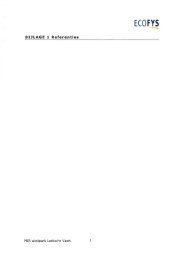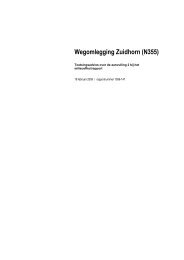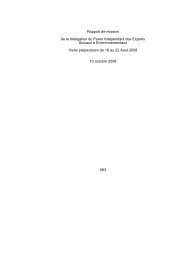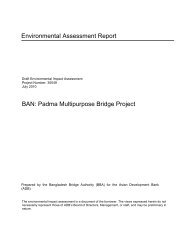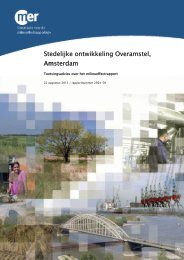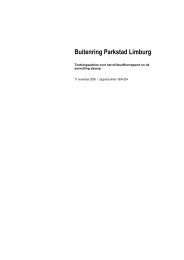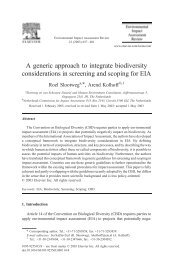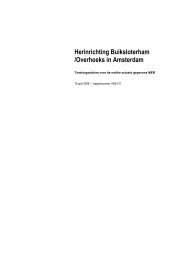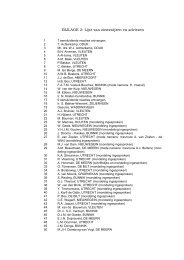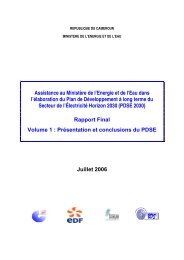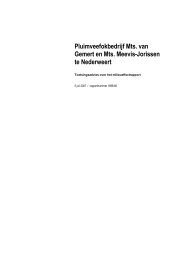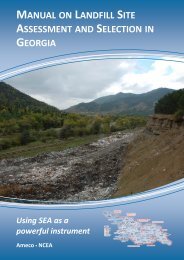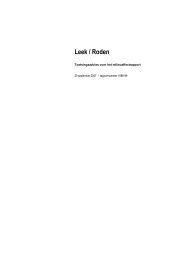Scoping Advice for the Dutch IWRM Support Programme Rwanda
Scoping Advice for the Dutch IWRM Support Programme Rwanda
Scoping Advice for the Dutch IWRM Support Programme Rwanda
Create successful ePaper yourself
Turn your PDF publications into a flip-book with our unique Google optimized e-Paper software.
3. <strong>Scoping</strong> part 2 – EKN’s <strong>IWRM</strong> <strong>Support</strong> <strong>Programme</strong>In this chapter, each of <strong>the</strong> three proposed components of <strong>the</strong> EKN’s <strong>IWRM</strong> support programmewill be discussed regarding progress made in <strong>Rwanda</strong> and possible added value of <strong>the</strong> EKN’ssupport programme. The chapter concludes with a fourth paragraph providing <strong>the</strong> way <strong>for</strong>wardwith regards to <strong>the</strong> SEA <strong>for</strong> <strong>the</strong> EKN’s <strong>IWRM</strong> support programme. <strong>Advice</strong> on SEA management anddesign and ToRs <strong>for</strong> <strong>the</strong> SEA’s will follow in chapter 4 and 5.3.1 Component 1: Monitoring systemThe complete component title and description in <strong>the</strong> NCEA’s ToR reads as follows 18 :“ Component 1: Operational Water Resources Assessment and Monitoring (WRAM) in place (nationwide). This WRAM system is planned, developed and operational in 15 districts. It will guidemanagement of river basins and catchments (in national and regional contexts) to guaranteereliable and climate-proof supplies of water <strong>for</strong> irrigation, hydropower and drinking water” . 19 :Data collection<strong>Rwanda</strong> faces an extreme shortage of reliable data on all aspects of water management. Little isknown at <strong>the</strong> various catchment levels.- Surface water levels are measured at 41 stations, not all in perfect working order. Data aresent by sms and automatically stored in a centralised web-based database 20 . Validation iscurrently taking place of <strong>the</strong> correct <strong>for</strong>mulas to calculate discharges based on <strong>the</strong>se waterlevels. O<strong>the</strong>r basic in<strong>for</strong>mation such as precipitation and evaporation is still missing (maindata available at <strong>the</strong> meteorology department of <strong>the</strong> Ministry <strong>for</strong> Infrastructure, (MININFRA)).- Groundwater levels are unknown and very little or no data collection seems to be taking place.- Presently a significant ef<strong>for</strong>t is being made by <strong>the</strong> Master Plan team to collect all available data(including land-use, water-use, etc.). Where data are lacking <strong>the</strong> team works with proxyindicators.While <strong>the</strong> RWRD is responsible <strong>for</strong> <strong>the</strong> coordination of water resources assessment andmonitoring, it is likely that data collection is taking place at o<strong>the</strong>r governmental institutions thatcould be of use to <strong>the</strong> RWRD. Water is part of nearly all <strong>the</strong> sector development plans of <strong>Rwanda</strong>and mandates are often shared. MININFRA <strong>for</strong> example is responsible <strong>for</strong> water supply andsanitation and also has a meteorological department. At <strong>the</strong> same time several projects havealready started or been carried out within <strong>the</strong> field of water resources management (<strong>the</strong> earliermentioned RIWSP project), irrigation (<strong>the</strong> LWH project) or WASH programmes.18 Description derived from NCEA’s ToR, see Appendix 119Description derived from NCEA’s ToR, see Appendix 120 source: hydrologist of RWRD14



